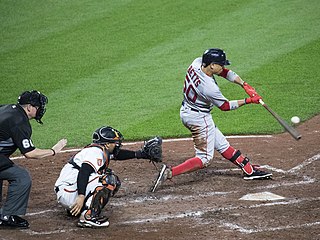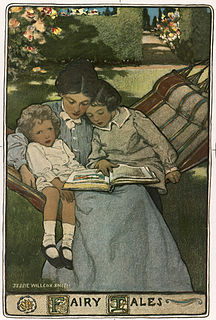
A Little Pretty Pocket-Book, intended for the Amusement of Little Master Tommy and Pretty Miss Polly with Two Letters from Jack the Giant Killer is the title of a 1744 children's book by British publisher John Newbery. [1]

A Little Pretty Pocket-Book, intended for the Amusement of Little Master Tommy and Pretty Miss Polly with Two Letters from Jack the Giant Killer is the title of a 1744 children's book by British publisher John Newbery. [1]
It is generally considered the first children's book, and consists of simple rhymes for each of the letters of the alphabet. To market the book to the children of the day, the book came with either a ball for a boy, or a pincushion for a girl. The book was very popular in England, and earned Newbery much fame; eventually the Newbery Medal was named after him. The book was re-published in Colonial America in 1762. [2] Dr A S W Rosenbach called this book, "One of the most influential and important books in the history of juvenile literature." [3]
The book includes a woodcut of stool-ball among other period games, and includes a rhyme entitled "Base-Ball." This is the first known reference to "base-ball" or "baseball" in print, [2] though it actually meant the game rounders, an ancestor of modern baseball. Of baseball's English origin: "The game of Rounders has been played in England since Tudor Times, with the earliest reference being in 1744 in 'A Little Pretty Pocketbook' where it is called baseball." [4] [5] "It is a striking and fielding team game, which involves hitting a small hard leather cased ball with a round wooden or metal bat and then running around 4 bases in order to score." [6]

Baseball is a bat-and-ball sport played between two teams of nine players each, taking turns batting and fielding. The game is live when the umpire signals to the pitcher either verbally or by pointing, indicating that the ball is now in play. A player on the fielding team, called the pitcher, throws a ball that a player on the batting team tries to hit with a bat. The objective of the offensive team is to hit the ball into the field of play, away from the other team's players, allowing its players to run the bases, having them advance counter-clockwise around four bases to score what are called "runs". The objective of the defensive team is to prevent batters from becoming runners, and to prevent runners' advance around the bases. A run is scored when a runner legally advances around the bases in order and touches home plate.

A nursery rhyme is a traditional poem or song for children in Britain and many other countries, but usage of the term dates only from the late 18th/early 19th century. The term Mother Goose rhymes is interchangeable with nursery rhymes.

Children's literature or juvenile literature includes stories, books, magazines, and poems that are created for children. Modern children's literature is classified in two different ways: genre or the intended age of the reader.

Rounders is a bat-and-ball game played between two teams. Rounders is a striking and fielding team game that involves hitting a small, hard, leather-cased ball with a rounded end wooden, plastic, or metal bat. The players score by running around the four bases on the field.
This article contains information about the literary events and publications of 1744.
The history of baseball can be broken down into various aspects: by era, by locale, by organizational-type, game evolution, as well as by political and cultural influence. The game evolved from older bat-and-ball games already being played in England by the mid-18th century. This game was brought by immigrants to North America, where the modern version developed. By the late 19th century, baseball was widely recognized as the national sport of the United States. Baseball is popular in North America and parts of Central and South America, the Caribbean, and East Asia, particularly in Japan, South Korea, and Taiwan.
The question of the origins of baseball has been the subject of debate and controversy for more than a century. Baseball and the other modern bat, ball, and running games — stoolball, cricket and rounders — were developed from folk games in early Britain, Ireland, and Continental Europe. Early forms of baseball had a number of names, including "base ball", "goal ball", "round ball", "fetch-catch", "stool ball", and, simply, "base". In at least one version of the game, teams pitched to themselves, runners went around the bases in the opposite direction of today's game, much like in the Nordic brännboll, and players could be put out by being hit with the ball. Just as now, in some versions a batter was called out after three strikes.

John Newbery, considered "The Father of Children's Literature", was an English publisher of books who first made children's literature a sustainable and profitable part of the literary market. He also supported and published the works of Christopher Smart, Oliver Goldsmith and Samuel Johnson. In recognition of his achievements the Newbery Medal was named after him in 1922.

Stoolball is a sport that dates back to at least the 15th century, originating in Sussex, southern England. It is considered a "traditional striking and fielding sport" and may be an ancestor of cricket, baseball, softball, and rounders. The sport has been called "cricket in the air". There is evidence to suggest that it was played as a tradition by milkmaids who used their milking stools as a "wicket" and the bittle, or milk bowl as a bat, hence its archaic name of bittle-battle.

"Sing a Song of Sixpence" is an English nursery rhyme, perhaps originating in the 18th century. It is listed in the Roud Folk Song Index as number 13191. The sixpence in the rhyme is a British coin that was first minted in 1551.

Children's poetry is poetry written for, appropriate for, or enjoyed by children.
Baseball is a growing, minor sport in the United Kingdom, with an estimated 22,500 people playing in 2020.

Welsh baseball, is a bat-and-ball game played in Wales. It is closely related to the game of rounders.
Events from the year 1744 in Great Britain.
Tommy Thumb's Pretty Song-Book is the first anthology of English nursery rhymes, published in London in 1744. It contains the oldest printed texts of many well-known and popular rhymes, as well as several that eventually dropped out of the canon of rhymes for children. A copy is held in the British Library. In 2013 a facsimile edition with an introduction by Andrea Immel and Brian Alderson was published by the Cotsen Occasional Press.

Baseball Before We Knew It: A Search for the Roots of the Game is a 2005 book by David Block about the history of baseball. Block looks into the early history of baseball, the debates about baseball's beginnings, and presents new evidence. The book received the 2006 Seymour Medal from the Society for American Baseball Research (SABR).

Toy books were illustrated children's books that became popular in England's Victorian era. The earliest toy books were typically paperbound, with six illustrated pages and sold for sixpence; larger and more elaborate editions became popular later in the century. In the mid-19th century picture books began to be made for children, with illustrations dominating the text rather than supplementing the text.
English baseball, is a bat-and-ball game played mainly in Merseyside, Liverpool. It is closely related to the game of rounders.